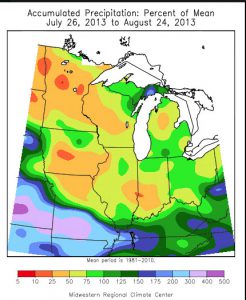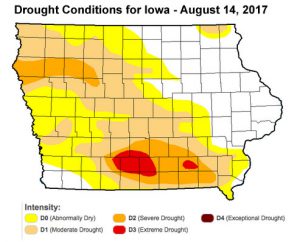With a dry Spring and little to no measurable rain in June and July, Brandon Patterson, Osceola Water Works Superintendent is looking at West Lake water levels with an impatient eye. While recent rains have helped green up a few lawns, water main breaks from the dry, cracking ground continue, not to mention the damage already done to crops and grazing land around Osceola and Clarke County has made an impact.
We’ve seen dry seasons like this in the past, and like in 2012, the last serious drought Clarke County had in recent years, this looks like the start of something pretty bad,” said Patterson.

Low precipitation in 2012 – 2013 lead to the worst drought in recent memory.
In 2012 low water levels caused one of the area’s worst droughts in recent memory. Farmland suffered and crops were wasted in the dry heat of the summer of 2012. While water conservation measures weren’t put into place in 2012, the levels at Osceola’s West Lake simply didn’t seem to recover. With an unexpectedly dry winter in 2012-13, Osceola went into spring of 2013 in desperate need of water. From there, it just got worse.
Five short years later, 2017 looks to be on pace for a replay. In January of 2013 Osceola Water Works released a Water Conservation Report to The Osceola Sentinel Tribune warning of the impending drought. By that time, the lake had dropped significantly, and water conservation measures were very close to being implemented, as outlined in the official Water Conservation Ordinance. As of August 14th of this year, West Lake looks to be mirroring data signs of drought conditions seen then. Monitoring levels closely, Patterson says the August 14th lake levels for this year are virtually identical to those of the 2012 measurements.
With the soil conditions we are currently dealing with and no secondary water reserve to speak of, West Lake is going to continue to drop, unless we get some prolonged rain fall,” said Patterson.
On top of the dry conditions, the usage for Osceola’s water supply has continued to increase. At last report, West Lake, at 306 acres, is able to maintain a safe daily withdrawal rate of 800,000 gallons per day in dry conditions. With expansion of businesses in the area and increased consumer water usage, the lake is currently pushing an annual average of 1.2 million gallons of water per day, over 60% more per day than is considered a safe withdrawal for the supply in West Lake.
This is where the new reservoir will really help,” said Patterson. “Being able to draw from a larger resource will reduce the risk of shortages and give the community growth capacity.”

Current drought conditions put Clarke County in a terrible position.
The proposed Clarke County Reservoir is set to be 789 acres, allowing the draw of Osceola’s current demand of 1.2 million gallons per day and additional capacity for future growth projections. And with the location chosen for the reservoir, the ability to properly treat the water as it’s sent to the plant will be enhanced. Due to the lack of treatment time from West Lake to the plant, additional costly measures have been needed. While progress has been made on the water quality issues, Osceola Water Works continues to battle taste and odor issues with the current reservoir.
Water levels will continue to fluctuate over the coming months. Depending on rain levels through August and into the fall, the conditions could continue to diminish. If the Midwest experiences another dry winter these could be signs of serious times for Osceola’s water supply.
